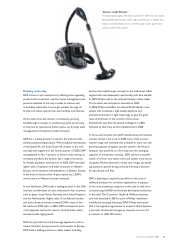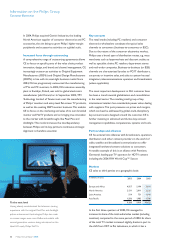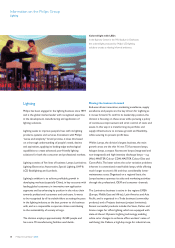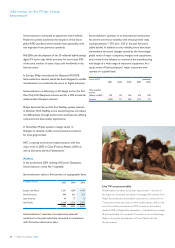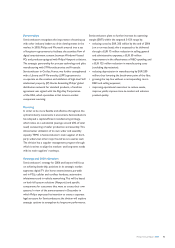Philips 2005 Annual Report Download - page 41
Download and view the complete annual report
Please find page 41 of the 2005 Philips annual report below. You can navigate through the pages in the report by either clicking on the pages listed below, or by using the keyword search tool below to find specific information within the annual report.Philips Annual Report 2005 41
Sourcing
Lighting sources most of its raw materials and mature
componentsfromChina/AsiaPacicandEasternEurope;
innovative components are sourced from Western Europe.
Volatility in the prices of raw materials such as steel and
copper may have consequences for Lighting’s business, and
in particular the Lighting Electronics activity.
Regulatory requirements
Lighting’s processes and products need to be consistent
with the relevant regional or national regulatory requirements.
Such legislation includes the EU WEEE (Waste from
Electrical and Electronic Equipment) Directive and the
RoHS (Restriction of Hazardous Substances) Directive.
Strategy and 2006 objectives
Lighting wants to realize comparable sales growth of
around 6% (including Lumileds) while maintaining a double-
digit EBIT margin. Building on strength in its existing
portfolio, it will seek to:
grow with its leading key accounts, supporting their
global expansion with worldwide co-ordinated support
in marketing, sales and supply performance;
build on its strong position in the value chain towards
professional end-users in Europe; here it has to
continuously upgrade the product-service offering,
thus creating for its business partners an upward spiral
of added value and customer satisfaction;
expand further in the fast-growing emerging
economies like China, India and Russia. It intends to
increase its distribution coverage and make better
use of local suppliers.
Lighting also wants to expand into new territories, where
it can shape its own future. To this end:
it will seek to expand its leading position in light
systems for image projection into the fast-growing
consumerapplicationsmarketforLCDatTVsand
digital rear-projection TVs;
it has embarked on a road towards solid-state lighting,
which is expected to lead to a fundamental industry
transformation. With its acquisition of Agilent
Technologies’ share in the Lumileds venture in 2005, it
has further strengthened its technology base. The task
now is to translate this into meaningful applications to
improve people’s lives with lighting.
•
•
•
•
•
Semiconductors
Philips Semiconductors has an established track record
of developing innovative semiconductor system solutions
that enable people to connect easily to each other and to
entertainment, information and services in the home and
on the move.
Semiconductors has a strong customer base consisting
of leading original equipment manufacturers (OEMs),
electronic manufacturing services (EMS) and original
design manufacturers (ODMs) in the Mobile & Personal,
Home,Automotive&IdenticationandMultiMarket
Semiconductors areas. It also works closely with established
global distribution partners, many of which distribute the
full portfolio of standard semiconductor products. Over
75% of total sales go to the division’s top 50 accounts.
One of Semiconductors’ most innovative solutions is
Nexperia, a system-on-chip (SoC) platform designed to
address the challenge of digital convergence. Nexperia’s
programmable ICs for multimedia applications offer the
‘next experience’ in streaming media. Highly integrated,
Nexperia products enable rapid application development
and short time-to-market, helping manufacturers to stay
up to date with – or ahead of – end-user demands in
the highly competitive consumer and communications
markets. In 2005 Nexperia accounted for 17% of Philips
Semiconductors’ total sales.
Semiconductorshassignicantinvestmentsinwafer-
fabrication ventures: approximately 51% in Systems on
Silicon Manufacturing Company (SSMC) and approximately
60% in Philips Jilin Semiconductor Company (PJSC).
Also, it has a 37% share in Advanced Semiconductor
Manufacturing Corporation (ASMC) and a 31% share in
the plant – operated together with STMicroelectronics
and Freescale Semiconductor – in Crolles, France. In
addition, Philips holds a stake of approximately 16% in
Taiwan Semiconductor Manufacturing Company (TSMC).
At the end of 2005 Philips Semiconductors had some
35,500 employees and 20 manufacturing plants in Europe,
the USA and Asia, and assembly and test facilities in Asia.
The division delivers to more than 60 countries.




